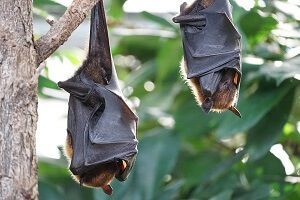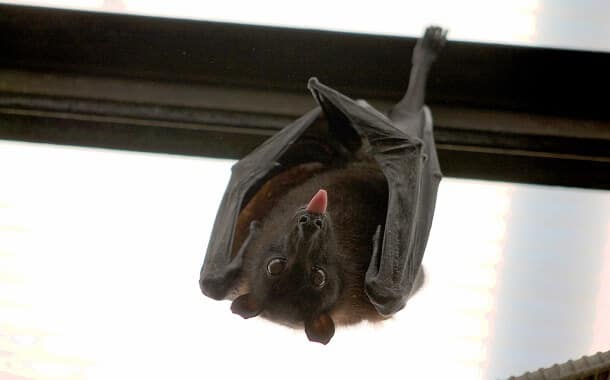Bat Removal Cost
Last Updated on December 27, 2023
Written by CPA Alec Pow | Content Reviewed by ![]() CFA Alexander Popinker
CFA Alexander Popinker
Average costs to expect:
- Single Bat: $90-$300
- Small-Medium Colony: $300-$1,500
- Large Colony: $1,500-$8,000+
As human constructions replace their natural habitats, bats are finding refuge in the most unlikely of places. Unlike other animals that only take shelter at night or on cloudy days, these winged creatures have adapted to living within our homes by seeking out man-made structures and spaces – such as attics, chimneys, and porches – where they can lay low for long periods of time without being disturbed. This is a problem because some bats carry diseases like rabies or histoplasmosis (a fungal infection caused by exposure to bat droppings).
Evicting bats from a house or other building is usually a process of exclusion — creating one-way exits through which the bats can leave but not return, while also sealing all other potential bat entrances. Because they fly up to 150 miles back to their original territory, trapping and poisoning them are ineffective tactics, but they’re also illegal actions under federal law (and in several states).
The typical prices
The prices for bat exclusion will depend on the size of the colony and the state of the building, including how many potential entry points need to be sealed. For example, it could cost $90-$300 to exclude a single bat with one hole in your home; this can go up as high as $1,500 for an average-sized colony (~50 bats). The price is just about doubled if you’re removing a medium-sized (about 50-200) population from your local area. If you have thousands of bats living near or inside your property, expect the removal costs to range anywhere around $8k.
You might also like our articles about the cost of flea extermination, beehive removal, or termite treatment.
For example, C&C Wildlife Management in New York charges $125-$275 to deal with a single bat inside living spaces. They offer regular exclusion services starting at $300 for up to 2,000 square feet of the home and charge an additional fee per extra floor or 1,000-square foot addition.
On the other hand, GetBatsOut notes that if you were to exclude bats from an average building that is in a good condition, then the costs you should prepare for will be anywhere between $2.500 and $5,000, depending mostly on the number of bats and the severity of the problem.
The cost of bat exclusion varies depending on factors such as the height of your house if a steep roof is present, and how difficult it will be to reach the colony. It will also cost more to remove bats from a poorly maintained house that features a lot of entry points.
Sometimes, when you ask an expert to help get rid of bats in your home, they will charge for cleanup. Cleaning up bat droppings or guano is sometimes necessary and can be expensive depending on how much it costs to repair the damage caused by them. BatManagement.com recommends waiting a year before contacting someone about cleaning up after getting rid of these creatures because there is a chance that they might come back. The price of guano cleanup will start at around $500 when dealing with small attics with finished floors.
Even though there are no homeowners’ insurance policies that we know of that will cover the actual bat removal process, most insurance plans will cover repairs of the damage to your home along with guano removal.
What should be included in the price?
 A bat exclusion specialist will start by inspecting the attic, roofline, and outer structure to find any potential roosting areas. Inspections are often scheduled for late afternoon or evening so that bats can be observed as they leave in their nightly feeding routine. The second step is sealing off all openings with only primary holes left open during this process – allowing them an opportunity to flee.
A bat exclusion specialist will start by inspecting the attic, roofline, and outer structure to find any potential roosting areas. Inspections are often scheduled for late afternoon or evening so that bats can be observed as they leave in their nightly feeding routine. The second step is sealing off all openings with only primary holes left open during this process – allowing them an opportunity to flee.
With the third step, you cover any holes with a device that will allow bats to leave but not get back in. Bat Conservation International has downloadable do-it-yourself instructions on how to prevent bat infestation and video tutorials for removing one pesky little bat from your house.
The best time for exclusion is typically the late spring or early fall, as this avoids excluding during breeding season when baby and juvenile bats are not able to leave on their own. Cornell University states that many of the signs associated with bat infestation can be hard to detect until there’s already an established colony in your attic, eaves, or elsewhere in your home; however they do include some red flags such as hearing noises coming from inside walls at night and seeing droppings near windowsills where clusters may hang out after dark.
Additional costs to be prepared for
A recent trend in bat conservation is the construction of artificial dwellings for bats. It can be difficult to coax a colony into leaving their old roosting site and moving on, but some people still try. The best way to attract them may be with an enticing new home that has plenty of room for all the bats in the colony.
With a low cost of $20-$300 or more depending on size and materials, many bat lovers are proud to show off their investment in the environment by building a bat house. A standard Bat Conservation International approved bat house can be as little as $50 with 7-chamber steel that holds up to 210 bats offered at only an average price range of about $160.
Looking for bat removal services
If you live in a house that has bats or are worried about having them move into your home soon, it is important to know the steps for bat exclusion. Bat Conservation International provides professional guidelines on how to go about this process and lists companies by state, that specialize in working with these animals. If there’s one of these creatures already hanging out inside your dwelling space (or if they seem like they might be moving their way over), then finding help from professionals as quickly as possible should be the top priority.
For those people who need assistance rescuing an injured bat without placing themselves at risk, going online can provide helpful information such as local rescue groups near where you reside; just remember: always find someone qualified first before handling any animal yourself! This means asking about their training and experience before hiring someone.


Leave a Reply
Want to join the discussion?Feel free to contribute!